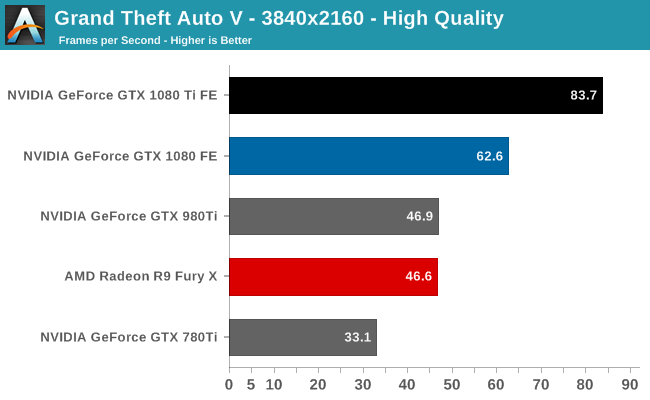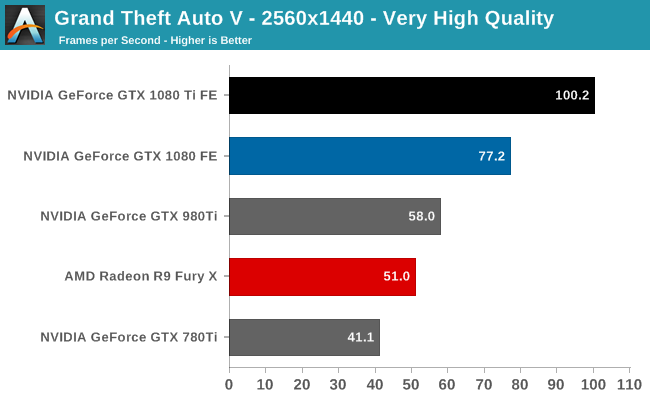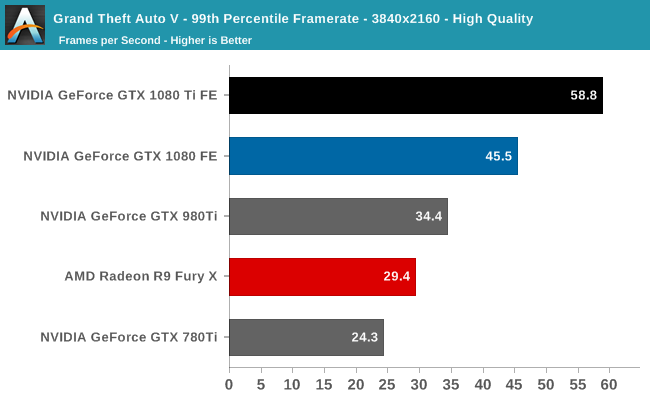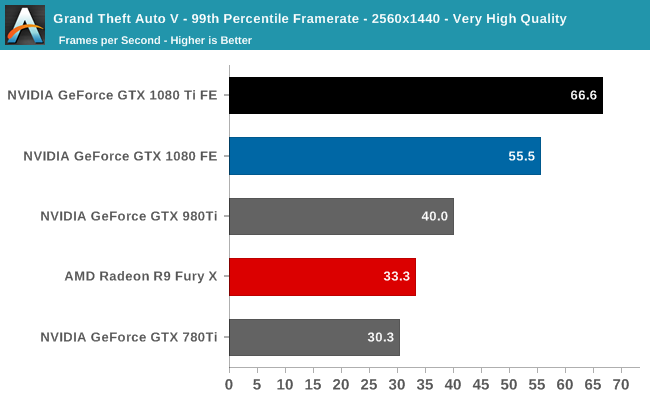The NVIDIA GeForce GTX 1080 Ti Founder's Edition Review: Bigger Pascal for Better Performance
by Ryan Smith on March 9, 2017 9:00 AM ESTGrand Theft Auto V
The latest edition of Rockstar’s venerable series of open world action games, Grand Theft Auto V was originally released to the last-gen consoles back in 2013. However thanks to a rather significant facelift for the current-gen consoles and PCs, along with the ability to greatly turn up rendering distances and add other features like MSAA and more realistic shadows, the end result is a game that is still among the most stressful of our benchmarks when all of its features are turned up. Furthermore, in a move rather uncharacteristic of most open world action games, Grand Theft Auto also includes a very comprehensive benchmark mode, giving us a great chance to look into the performance of an open world action game.
On a quick note about settings, as Grand Theft Auto V doesn't have pre-defined settings tiers, I want to quickly note what settings we're using. For "Very High" quality we have all of the primary graphics settings turned up to their highest setting, with the exception of grass, which is at its own very high setting. Meanwhile 4x MSAA is enabled for direct views and reflections. This setting also involves turning on some of the advanced redering features - the game's long shadows, high resolution shadows, and high definition flight streaming - but it not increasing the view distance any further.
Otherwise for "High" quality we take the same basic settings but turn off all MSAA, which significantly reduces the GPU rendering and VRAM requirements.



Grand Theft Auto V is another game where the GTX 1080 Ti won’t quite reach 60fps at 4K with all the bells & whistles, but it gets close in doing so. Given that this was originally a console game that ran at 30fps, 51.1 should make a lot of people reasonably satisfied, but there’s always room for improvement.
Relative to the GTX 980 Ti, this is actually the GTX 1080 Ti’s best game; it picks up a better-than-average 83% in performance. I suspect that GTAV is an outlier that is especially memory bandwidth sensitive, benefitting from the combination of a raw 44% increase in memory bandwidth from the previous generation, and NVIDIA’s improved memory compression technology on the Pascal architecture.



Looking at the minimum framerates, the story is much the same. For gamers looking for high minimum framerates, the GTX 1080 Ti is the first card that can deliver better than 30fps at the 99th percentile. So while it can’t average 60fps, it also will never drop to the 30fps rate that its console counterparts are capped at in the first place.










161 Comments
View All Comments
Jon Tseng - Thursday, March 9, 2017 - link
Launch day Anandtech review?My my wonders never cease! :-)
Ryan Smith - Thursday, March 9, 2017 - link
For my next trick, watch me pull a rabbit out of my hat.blanarahul - Thursday, March 9, 2017 - link
Ooh.YukaKun - Thursday, March 9, 2017 - link
/clapsGood article as usual.
Cheers!
Yaldabaoth - Thursday, March 9, 2017 - link
Rocky: "Again?"Ryan Smith - Thursday, March 9, 2017 - link
No doubt about it. I gotta get another hat.Anonymous Blowhard - Thursday, March 9, 2017 - link
And now here's something we hope you'll really like.close - Friday, March 10, 2017 - link
Quick question: shouldn't the memory clock in the table on the fist page be expressed in Hz instead of bps being a clock and all? Or you could go with throughput but that would be just shy of 500GBps I think...Ryan Smith - Friday, March 10, 2017 - link
Good question. Because of the various clocks within GDDR5(X)*, memory manufacturers prefer that we list the speed as bandwidth per pin instead of frequency. The end result is that the unit is in bps rather than Hz.* http://images.anandtech.com/doci/10325/GDDR5X_Cloc...
close - Friday, March 10, 2017 - link
Probably due to the QDR part that's not obvious from reading a just the frequency. Thanks.